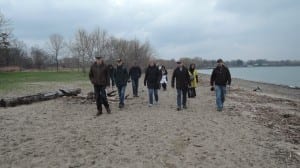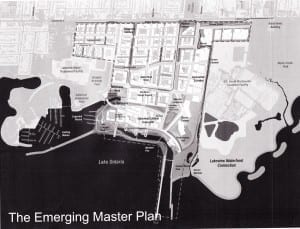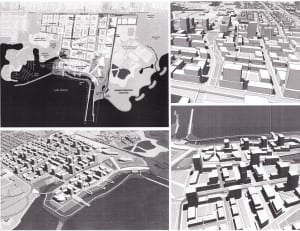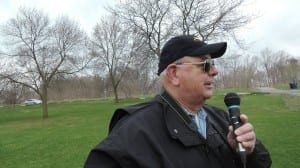Anecdotes Shared by Fellow Walkers – May 5, 2014 post by Jaan Pill at Jane’s Walk website
I’ve recently posted a blog item for the Toronto Walks Blog of the Jane’s Walk website.
I’ve enjoyed writing this item, because it enables a person to consider the broader issues of interest to anybody who lives close to the Lake Ontario shoreline – in Mississauga, Toronto, or anywhere else along this or any other lake.
Below you will find the text and images from the post.
Anecdotes Shared by Fellow Walkers: What we especially enjoyed were the anecdotes shared by so many people
Jaan Pill, May 5, 2014
This post is concerned with the two Jane’s Walks that took place in Long Branch on May 3 and 4, 2014 along the Lake Ontario shoreline starting from a point close to the Mississauga-Toronto border.
It will be useful to begin by describing the three communities that comprise the waterfront neighbourhoods in south Etobicoke.
Geographical boundaries
Along the Lake Ontario shoreline, south Etobicoke comprises three communities:
1) Long Branch extends from the Mississauga-Toronto border located to the west of Etobicoke Creek to Twenty Third Street.
2) The next community to the east is New Toronto, which extends from Twenty Third Street to Dwight Avenue.
3) The third community is Mimico, which extends from Dwight Avenue to the Humber River. Some residents claim that Park Lawn Road is its eastern border. City of Toronto planners, however, identify the Humber River as its eastern boundary. The neighbourhood between Park Lawn Road and the Humber River is known as Humber Bay Shores.
Lakeview in Mississauga
To the west of south Etobicoke is the Lakeview community in Mississauga.
Our Jane’s Walk in Long Branch on May 3, 2014 focused on the sand beach to the west of Etobicoke Creek and the redevelopment taking place in Lakeview.
Our Jane’s Walk the next day, May 4, 2014, began at the same location at Marie Curtis Park at the mouth of Etobicoke Creek. On that day, however, we travelled east toward the Lakeshore Hospital Grounds in New Toronto.

Participants in May 3, 2014 Jane’s Walk on their way along the sand beach from Etobicoke Creek – in the background – to Applewood Creek near where the Mississauga-Toronto boundary is located. The boundary is based on where the western and southern branches of Etobicoke Creek used to run in the Cottage Country era before they were filled in by the 1950s. Jaan Pill photo
The photo shows walkers on May 3, 2014 on their way along the sand beach from Etobicoke Creek – in the background – to Applewood Creek, to the west of which the Mississauga-Toronto border is located. The boundary – in this area close to the lake – is based on where the western and southern branches of Etobicoke Creek used to run in the “cottage country” era before they were filled in during the 1950s. The sand beach is actually in Toronto.
You can enlarge this and other images at this post by clicking on it. Click again to enlarge it further.
During a previous walk in this area on May 5, 2013, we shared the news that the Lakeview Waterfront Connection Project, which is concerned with the lands west of Etobicoke Creek, was proposing to replace the sand beach with a pebble beach. Originally, residents of Toronto, where the beach is located, had not been informed of the plans. Once they knew, as we explained on our May 3, 2014 walk, they made their views known. The outcome of a series of ensuing meetings was that most of the sand beach will stay as it is.
Unlike Toronto, Mississauga does not build tall condos along the waterfront
Mississauga is the site of Inspiration Lakeview, a community-initiated, community-driven redevelopment project in Lakeview. The project has the support of the City of Mississauga and the Ontario government.
The City of Mississauga councillor for Lakeview is the former president of the Lakeview Ratepayers Association, which has been a driving force behind Inspiration Lakeview.
The project envisions redevelopment along the Mississauga waterfront primarily featuring mid-rise condos and stacked townhouses along with great views of the lake, extensive green spaces, and public transit.
Mississauga has a policy of not building tall condos on its waterfront. In contrast, a wall of tall condos has emerged in Toronto along the lake at Humber Bay Shores. Additional very tall condos are currently under construction in the area.
The councillor for Ward 6 in south Etobicoke made an attempt in 2013 to provide “incentives” to developers seeking to build along the Mimico waterfront. The attempt was rejected in a February 2013 vote by Toronto City Council.
The City of Toronto has enacted a Mimico Secondary Plan to guide development along the Mimico waterfront. The plan sets limits on the heights of future buildings along this stretch of lake. Concern has been expressed, however, that developers will get permission from the Ontario Municipal Board to build taller buildings than permitted under the secondary plan.
Jane’s Walk as walking conversation
What has stayed in mind, from our walks on May 3 and 4, are the frequent comments that we’ve heard about how enjoyable it was to hear anecdotes from so many people.
Many of the anecdotes were first-person accounts related to buildings, railway lines, pickup football games, and landscapes that people recalled from the 1940s and 1950s. Actually seeing a place and hearing a first-hand account of what was happening there 60 or 70 years ago can be a great experience.
In this our third year, we achieved more success than previously in turning each walk into a walking conversation.
The walk leaders had plenty of data to share, but their views did not take centre stage.
Portable amplifier
We used a microphone and portable amplifier from Long and McQuade each day, to ensure that everybody could hear the walk leaders, and to make it easy for any person to step forward and share an anecdote. The microphone provided a clear procedure for turn taking, under conditions where each speaker could direct their remarks to the entire group.
Each walk ended at a local, independent coffee shop, the Fair Grounds Organic Roastery and Cafe, where walkers redeemed free coffee coupons distributed at the start of each walk. On Saturday, we ended the walk at the Fair Grounds Cafe at Fortieth Street and Lake Shore Blvd. West. On Sunday, the last stop was the new Fair Grounds Cafe at Twenty Fourth Street and Lake Shore.
Since 2012, we’ve learned how to set the stage for a conversation
When planning our first walk, in 2012, we learned that a Jane’s Walk could be viewed as being in the nature of a conversation. At that point, we had only a vague idea of what this meant.
By the third year, in 2014, we did really well with regard to the walking conversation scenario. We also found it noteworthy that several walkers who joined us on the Saturday, when we headed west from Marie Curtis Park, also joined us when we headed east from the park the next day. That’s a testimonial to the fact these walks were lots of fun.
3P Strategy: Proactive, Persistent, and Positive
The Saturday, May 3, 2014 Jane’s Walk began at our usual time and location – at 10:30 am at the East Parking Lot at Marie Curtis Park. The walk was called Inspiration Lakeview: Proactive, Persistent, and Positive.
This wasn’t the original title. We had posted a much longer title but Katherine Keyes, a Jane’s Walk Outreach Intern, contacted us and suggested the shorter title. The final title that we chose worked much better than the earlier one we had come up with.
We much appreciate the attention to detail that the Jane’s Walk organization demonstrates to help walk leaders to put together the best possible walks.
The image above is from page 92 of a March 18, 2014 Inspiration Lakeview report. The original page is in colour. The image – which gives people a sense of the immense scope of the project – was one of our Jane’s Walk handouts. These days we usually print documents in black and white, as it reduces our costs.
As with the other images at this post, you can click on the image to enlarge it. Click again to enlarge it further.
At the outset of the May 3, 2014 Jane’s Walk in Long Branch, we referred to the 3P Strategy that has been a key organizing principle for Inspiration Lakeview. The concept is closely associated with City of Mississauga Ward 1 Jim Tovey’s approach to the development of the Lakeview Legacy Project. The latter project originally took on the task of dealing with a very large tract of land in Lakeview made up of smaller land areas.
As Jim Tovey has remarked in an August 2013 interview, the lands carry with them a history of 120 years of industrial, military, and utility pollution.
In seeking to deal with the lands, the Lakeview community developed what is know as the 3P Strategy, based upon the following principles:
1) Proactive
Proactive: Be proactive in identifying what negatively impacts your community, and more importantly, what may negatively impact your community in the near or distant future.
2) Persistent
Persistent: Be persistent in gaining, and sharing with your community, the knowledge required to make fair, informed decisions, and to be able to engage all stakeholders in the discussion.
3) Positive
Positive: Never offer a solution to a difficult issue unless it is a positive solution. If you cannot find a solution where there are no losers, revert to the second “P,” Persistent.
Above is page 93 from the above-noted document. It shows that most buildings in Lakeview will be mid-rise condos or stacked townhouses. This page was also included as a handout.
Again, you can click on the image to enlarge it. Click again to enlarge it further.
A third handout was concerned with a Feb. 25, 2013 Etobicoke Guardian report about the rejection, by Toronto City Council, of “incentives’ to developers seeking to build along the Mimico waterfront.
Citizens leading the call
The Lakeview Ratepayers Association adopted a set of operational principles for its work. The principles applied to everything the ratepayers association did, as noted in a post at the Preserved Stories website, in “working bottom-up in a planning system that was not used to citizens leading the call for regeneration and sustainability.”
The 3P Strategy was implemented to achieve local community, shared community, bureaucratic and political buy in. The Lakeview community took the view that there must be a creative way to find solutions that did not create losers.
It was not always possible, as noted in a post at the Preserved Stories site, to create the win-win situation, but it was possible to identify core values and negotiate ways to protect those interests. The attitude shifted the mindset from the usual notion of asking authorities to fix problems to one of championing a positive alternative to the status quo.
By way of rounding out our discussion, below are links to brief videos from our May 3 Jane’s Walk.
Video – David Webster (42 seconds)
Our first video at this post features David Webster.
David’s participation in our May 3 walk underlines the beneficial role that social media can play in bringing long-time Long Branch residents together to share anecdotes related to local history. David originally contacted us through the Preserved Stories website.
Here’s a video of one of the anecdotes that David Shared with us, as we stood near the corner of Forty Second Street and Lake Shore Blvd. West, with a view toward Lake Ontario:
Football games at the mouth of Etobicoke Creek (42 seconds)
Video – Mike James (38 seconds)
Our second video features Mike James, who grew up in New Toronto and has many memories of the local communities in the 1960s. The video is from a stop that we made close to the leash-free dog park on the east side of Etobicoke Creek not far from Lakeshore Road East in Mississauga. He speaks of the value of having access to public lands – in the past and the present:
Mike James speaks of the value of access to public lands (38 seconds)
Video – Brian Liberty (2 minutes)
At the end of our May 3, 2014 Jane’s Walk, our conversation continued at the Fair Grounds Organic Roastery and Cafe at Fortieth Street and Lake Shore Blvd. West, where walk participants enjoyed complimentary coffees. In the following video, Brian Liberty describes a project in New Toronto aimed at setting up a Community Garden near the corner of Kipling Avenue and Lake Shore Blvd. West at the Ontario Hospital Grounds:
Brian Liberty describes Community Garden project in New Toronto (2 minutes)
Long Branch Hotel
Videos are a great way to share local stories
Before the May 4, 2014 Jane’s Walk in Long Branch began, I went to Long Branch Furniture on Lake Shore Road East to visit Bill Rawson.
I met him in the morning, before the walk, to see if he’d be at his store later in the morning, so that we could visit him, but it turned out he was heading for the horse races at Woodbine at 10:30 am, which is when our walk was beginning.
Much of what I know about the layout of the Long Branch Resort, and the story of how the Long Branch Hotel burned down in 1958, I’ve learned from Bill Rawson.
I originally met Bill when Carol Milroy, a Long Branch resident, introduced me to him at Long Branch Furniture on Lake Shore Blvd. West across from the Long Branch Library. The introduction occurred on May 6, 2012 just after the Long Branch Jane’s Walk that was held that day.
Over the years, I had often seen Bill Rawson sitting outside the store, with furniture arranged along the sidewalk, shooting the breeze with his friends. I had thought, “I have to go visit this guy; he might have some interesting stories to share.” But until Carol Milroy introduced us, I hadn’t spoken with him.
Long Branch GO Station
So, around 9:30 am on May 4, 2014, Bill Rawson told me a bit about the community that used to exist around where the Long Branch GO Station is now located. Here’s a 2-minute video in which he describes the neighbourhood 60 and 70 years ago:
Around where the Long Branch GO Station is now located was a thriving community in the 1950s





Leave a Reply
Want to join the discussion?Feel free to contribute!